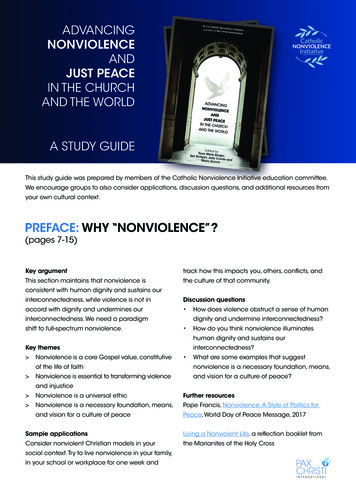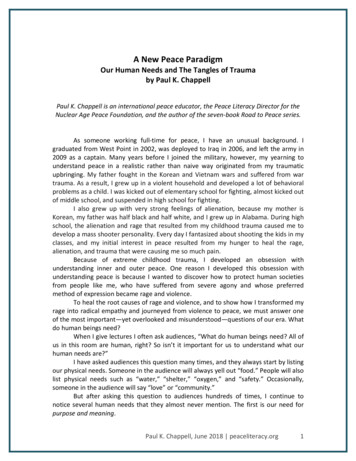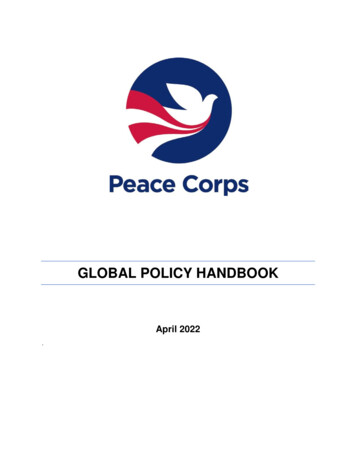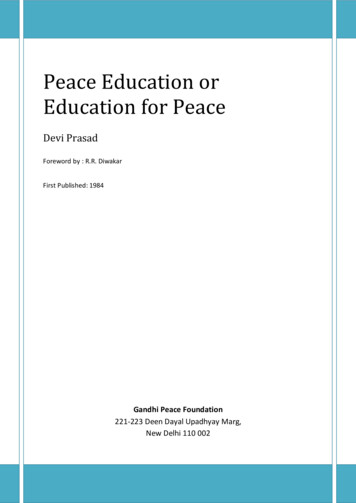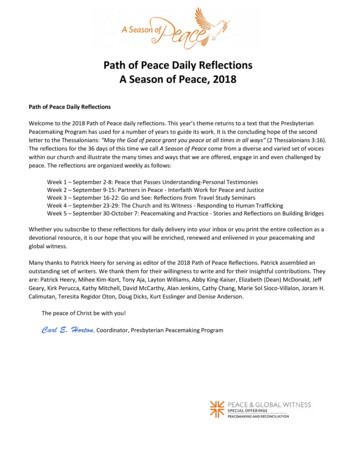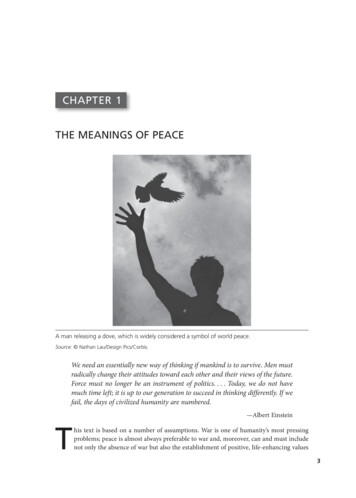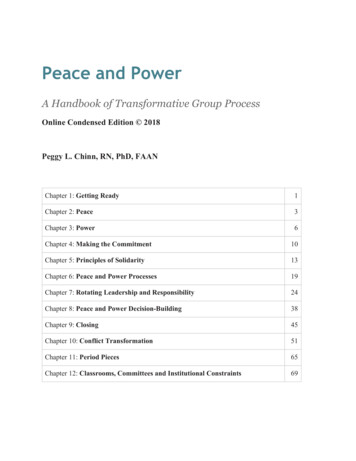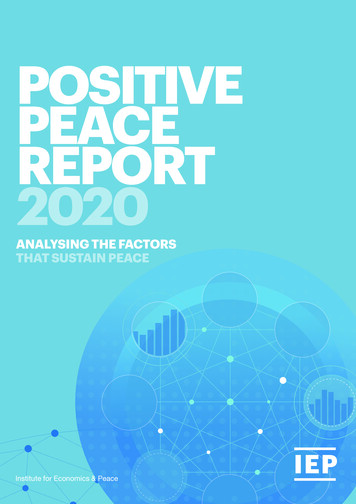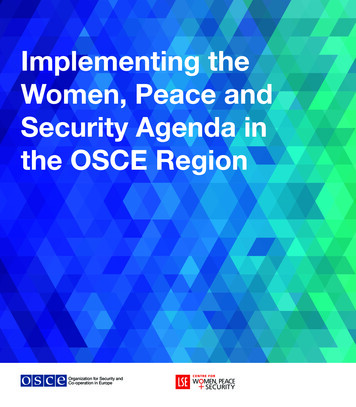
Transcription
Implementing theWomen, Peace andSecurity Agenda inthe OSCE RegionOrganization for Security andCo-operation in Europe1
Implementing the Women, Peace and Security Agenda in the OSCE RegionAuthors: Henri Myrttinen, Laura J Shepherd, and Hannah Wright.Editing and proofreading: Leena Avonius, OSCE Gender Adviser; Nicky Armstrong,Communications Manager, LSE Centre for Women, Peace and Security.Design and typesetting: Ana Prpic, Brand May Ltd.Printed by: Ferdinand Berger & Soehne Gesellschaft M.B.H.ISBN- 978-3-903128-53-8 2020 Organization for Security and Co-operation in Europe (OSCE); www.osce.orgAll rights reserved. No part of this publication may be reproduced, stored in a retrieval system, ortransmitted in any form or by any means — electronic, mechanical, photocopying, recording, orotherwise without the prior written permission of the publishers. All photos used in the publicationare copyrighted and remain the full property of the OSCE or the LSE Centre for Women, Peace andSecurity unless specified otherwise.The materials in this publication are for ease of reference only. Although the OSCE and the Centrefor Women, Peace and Security, London School of Economics and Political Science (LSE WPS)have invested the utmost care in its development, they do not accept any liability for the accuracyand completeness of any information, instructions and advice provided or for any misprints. Thecontents of this publication, the views, opinions, findings, interpretations and conclusions expressedherein are those of the authors and contributors and do not necessarily reflect the official policy orposition of the OSCE and its participating States or the LSE WPS. For these reasons no claims canbe made against the OSCE or the LSE WPS in respect of potential consequences from the relianceon information or conclusions contained in this publication.2
Implementing theWomen, Peace andSecurity Agenda inthe OSCE Region3
4
ContentsLIST OF ABBREVIATIONSFOREWORD 3EXECUTIVE SUMMARY 51. INTRODUCTION 82. REVIEW OF RESEARCH ON NATIONAL ACTION PLANS113. DESK-BASED ANALYSIS OF NAPS IN THE OSCE REGION173.1: Learning from the previous study 183.2: Thematic priorities 253.3: New and emergent themes 293.4: Co-ordination mechanisms 343.5: Financing 373.6: Monitoring and evaluation 393.7: Inclusive practice 413.8: Conclusions 434. NAP IMPLEMENTATION IN THE OSCE REGION444.1: Background to country contexts 454.2: Co-ordination and ownership of NAPs484.3: NAP development processes 504.4: NAPs and the broader NWM/other Action Plans524.5: Thematic focus areas 554.6: NAP implementation and budgeting 604.7: Localization 664.8: Monitoring, evaluation, reporting, and impact704.9: Context-specific challenges 714.10: External support 725. CONCLUSIONS AND RECOMMENDATIONS 75Recommendations 76Annex: Summary of OSCE NAP dataset795
List ofAbbreviationsAPPGAll Party Parliamentary GroupCEDAWConvention on the Eliminationof All Forms of DiscriminationAgainst WomenCRSVConflict-related sexual violenceCSOCivil society organisationDCAFDCAF – the Geneva Center forSecurity Sector GovernanceEUEuropean UnionFIGAPFinancial Mechanism for Implementation of Gender ActionPlan in Bosnia and HerzegovinaGAPGender Action PlanGAPS UKGender Action for Peace andSecurity UKGBVGender-based violenceGFPsGender Focal PointsICTYInternational Criminal Tribunalfor the former YugoslaviaIDPInternally displaced personINGOInternational non-governmentalorganisationLAPLocal Action PlanLGBTILesbian, gay, bisexual, transgender and/or intersexM&EMonitoring and EvaluationMoDMinistry of DefenceMOHLSPMinistry of Health, Labour andSocial ProtectionMoIMinistry of the InteriorMoESMinistry for EmergencySituations6MOSMinistry of SecurityMOSPMinistry of Social ProtectionNAPNational Action Plan onWomen, Peace and SecurityNATONorth Atlantic TreatyOrganisationNWMNational Women’s MachineryOSCEOrganisation for Security andCo-operation in EuropePSOPeace Support OperationPSVIPreventing Sexual ViolenceInitiativePVEPreventing Violent ExtremismRSRepublika SrpskaSALWSmall Arms and Light WeaponsSDGsSustainable DevelopmentGoalsSEASexual Exploitation and AbuseSGBHSexual and gender-basedharassmentSOGIESexual orientation, genderidentity, and gender expressionSSISecurity Sector InstitutionsSViCSexual Violence in ConflictUNFPAUnited Nations PopulationFundUNODCUN Office on Drugs and CrimeUNSCRUnited Nations Security CouncilResolutionVAWGViolence against women andgirlsWPSWomen, Peace and Security
ForewordThis year marks the twentieth anniversary of the adoption of United Nations SecurityCouncil resolution 1325 on Women, Peace and Security. The anniversary provides a goodmomentum for examining how far have we progressed in implementing the UNSCR 1325and the nine related resolutions.Are we now better in protecting women and girls from conflict-related violence? Have wefound more effective ways to enable women to fully participate in processes related topeace and security?In 2014, the OSCE released a study on National Action Plans on the implementation ofthe UNSCR 1325. This new study builds on the key findings and recommendations of the2014 publication. One key positive development can be seen in the increase of the numberof NAPs from 27 to 36 during the last five years. Over 60 per cent of OSCE participatingStates now have a NAP on UNSCR 1325. Growing commitment at the national level is alsoreflected in frequent discussions on women, peace and security during the formal OSCEmeetings in Vienna.The study at hand shows that much work and effort has been put into designing better andmore effective NAPs to implement the UNSCR 1325 across the OSCE region. Examination ofthe NAPs indicates that women’s participation in peace and security governance processesand institutions remains to be a priority area for OSCE participating States. In recent yearsmore attention has also been given to conflict prevention, as well as on preventing andcountering terrorism and violent extremism. The study also provides some insights on howvarious gender equality and security strategies and action plans can be synchronized andco-ordinated in order to avoid duplications, overlaps, and contradictions.NAPs on Women, Peace and Security have turned out to be an effective tool to supportreform processes in national security sector institutions. Numerous examples given in thisstudy show that the security sector institutions feel ownership of these action plans, andrecognize the benefits the implementation of NAPs have brought to their everyday work.3
In the 2004 Action Plan for the Promotion of Gender Equality the 57 participating Stateshave committed the OSCE to support the implementation of the Women, Peace andSecurity agenda in the OSCE region. We have done so by building capacities for designingmore results-oriented NAPs on UNSCR 1325. The OSCE’s field operations, institutionsand Secretariat departments have also built up capacities to better implement the NAPs.Targeted trainings for security sector personnel on women, peace and security, or helpingdevelop measures to increase the inclusion of women in the security services are examplesof OCE support in this field.A striking finding of this study is the lack of funding for the implementation of Women, Peace andSecurity commitments. After 20 years of implementation, 86 per cent of participating States’NAPs have minimal or zero information on budget or financing mechanism. Unfortunately,this reflects a global reality. We clearly can do better than this. The recommendationsprovided in this publication also bring up a number of other remaining challenges in NAPsand their implementation, engaging us for developing ways address them.I would like to thank the OSCE Secretariat’s Gender Section for leading the OSCE’s workto support the implementation of WPS in our region. The group of researchers have donean excellent job in painting for us this rich picture of WPS activities and dynamics in theOSCE region. We are also grateful that such a large number of government and civil societyrepresentatives provided their expert views and insights for this study. The OSCE fieldoperations in the five participating States deserve a special thanks for their invaluable helpfor this research. I would also like to thank the LSE Centre for Women, Peace and Securityfor partnering with the OSCE in preparing this publication.Thomas GremingerOSCE Secretary General4
Executive SummaryAs the largest regional security organization in the world, the OSCE has committed itselfto support the implementation of the women, peace and security (WPS) agenda in its 57participating States.This commitment has been outlined in the OSCE 2004 Action Plan for the Promotion ofGender Equality, in which women’s participation in conflict prevention, crisis managementand post-conflict rehabilitation is enlisted as a priority area of work. At the time of writing,over 60 per cent of the OSCE participating States (36) have adopted a National Action Plan(NAP).This study provides research-based evidence on the implementation of the WPS agendaacross the OSCE region. After providing an introduction to the WPS agenda and the OSCE’swork on its implementation it offers a brief discussion of research on the implementationof the WPS agenda through the development and adoption of NAPs. Chapter Threepresents a desk-based analysis of NAPs from the OSCE region. Chapter Four consists ofan assessment of the WPS NAP implementation in Bosnia and Herzegovina, Kyrgyzstan,Moldova, Serbia and Ukraine. It draws on field research conducted by the authors in thefive countries, consisting of interviews and focus group discussions with relevant membersof state agencies, civil society, academia as well as UN agencies and OSCE staff. Theconcluding chapter presents recommendations for future development of NAPs in theOSCE region.The desk-based analysis of NAPs in the OSCE region shows that the range of issues theycover is growing, although attention is still paid to the traditional “pillars” of WPS activity,notably participation and prevention. There has been an increased focus on preventionsince 2014 and NAPs have begun to feature emerging WPS issues such as disasters andviolent extremism. In terms of the features that make for an effective NAP, much roomfor improvement remains in the sphere of budgeting and the specification of financialarrangements, as most NAPs in the OSCE region do not feature even a “broadly defined”budget, let alone specific allocations to defined agencies or initiatives. Specification ofmonitoring and evaluation (M&E) has remained somewhat steady since 2005, and much5
greater levels of specificity are evident in the sphere of M&E than in budgeting. Since 2014there has been a marked uptick in levels of inclusive practice specified in the NAPs, thoughthey could offer better opportunities for civil society involvement.The field research did not aim to compare the different NAPs, as this would not have beenpossible given how different they are and how they are at different stages. Rather, theresearch examined a range of issues, such as how the NAPs were developed, where inthe state structure the NAP was anchored, how well reporting processes functioned, howthe WPS NAPs related to other women’s empowerment and gender equality strategies andaction plans, and how localization processes of NAPs were working.Various good practices emerged from both desk-based and field research, which inform therecommendations summarized below. The recommendations are grouped into three phasesof NAP activity, with a further set of recommendations for the OSCE and other internationalorganizations supporting NAP development and implementation. The recommendations areelaborated in the report; summary recommendations only are presented here.Phase 1: Framing and developing NAPs Undertake knowledge-sharing activities across contexts facing similar challenges Ensure the participation of individuals and civil society organization (CSO)representatives from diverse backgrounds Integrate specified budgets for all dimensions of NAP activity, and considergender-responsive budgeting Ensure harmonization between WPS NAPs and other gender equality-relatedstrategies6
Executive SummaryPhase 2: NAP implementation Ensure ownership, buy-in and understanding of WPS at all levels of government,including local administrative structures Integrate WPS tasks and performance indicators into job descriptions andperformance reviews Reform institutional regulations to open up security and defence institutions towomen Ensure adequate institutional support to gender advisers and gender focal pointsPhase 3: Monitoring, evaluation, reporting, and impact Ensure entities responsible for M&E have the necessary skills and resources Harmonize reporting processes for gender- and security-related action plans Create opportunities for collective problem-solving among implementingministries and institutions Set-up a dedicated parliamentary body responsible for scrutinizing NAPimplementationRecommendations for OSCE and other international organizations Forge closer links between gender advisers and gender focal points inimplementing agencies across participating States Facilitate regular and inclusive ways of sharing good practice amongparticipating States Develop accessible resources to guide the development, implementation,and M&E of NAPs across participating States Support to find better ways to implement WPS principles and commitmentsin the peace processes7
1. IntroductionThe United Nations Security Council adopted the resolution (UNSCR) 1325 on Women,Peace and Security (WPS) in October 2000.Since 2000 the UN Security Council has adopted nine related resolutions, comprising aglobal policy framework under the title of the “Women, Peace and Security agenda” (seeTable 1 for a summary). As the largest regional security organization in the world, the OSCEhas committed itself to support the implementation of the Women, Peace and Securityagenda in its 57 participating States. This commitment has been outlined in the OSCE2004 Action Plan for the Promotion of Gender Equality, in which women’s participation inconflict prevention, crisis management and post-conflict rehabilitation is enlisted as a priorityarea of work. Furthermore, the Action Plan tasks all OSCE structures, as appropriate withintheir mandate, to promote the implementation of United Nations Security Council resolution1325 (2000) on the role of women in, inter alia, the prevention of conflicts and post-conflictreconstruction. Several other OSCE Ministerial Council decisions have since reiterated theOSCE’s commitment to support the implementation of UNSCR 1325.The number of National Action Plans to implement the Women, Peace and Security agendahas steadily grown globally and in the OSCE region since 2010. Of 57 participating Statesin the OSCE region, 36 (63 per cent) have current NAPs for the implementation of UNSCR1325 and subsequent resolutions adopted by the Security Council under the title of “womenand peace and security”. Several participating States have released more than one iterationof their NAPs (see Annex).OSCE support to the participating States in this field has focused on enhancing capacities ofgovernment and civil society actors to design results-oriented action plans. OSCE ExecutiveStructures are also in various other ways engaging in supporting the implementation ofUNSCR 1325 by the participating States. These include for example gender trainingseminars for security sector actors and oversight bodies, promoting inclusion of women inthe security sector, as well as in mediation and dialogue-facilitation efforts, and training and8
Introductionawareness-raising on how to prevent and respond to sexual and gender-based violence(see also section 4 on support by the OSCE and other international actors).In 2013, the OSCE undertook a study on the implementation of the Women, Peace andSecurity agenda in the OSCE region through an analysis of the 27 NAPs on the implementationof UNSCR 1325 in the region. The aim of the study was to provide tangible tools for actionfor the revision or development of such plans. It highlighted common challenges and sharedgood practices from the OSCE region. The present report builds on and updates thefindings of the 2014 study, with a view to examining the dynamics of implementation, butincludes analysis of WPS activity in the OSCE region since 2005 in order to capture changeover time. This report aims to: provide research-based evidence on the implementation ofWPS agenda across the OSCE region; increase capacities of government and civil societyactors in the OSCE participating States to enhance the implementation of WPS agenda;and provide guidance to the OSCE staff members on how to promote the WPS agendain the OSCE region. OSCE support to the participating States could be more strategicallydesigned and targeted as a result of this analysis and related recommendations.The report is presented in five parts, including this introductory section. Part 2 provides a briefdiscussion of research on the implementation of the WPS agenda through the developmentand adoption of NAPs. Part 3 presents an analysis of the curated dataset of 75 NAPs fromOSCE participating States. For analysis of shifts over time, the full dataset is used. Foranalysis of contemporary trends and dynamics, only the 36 current NAPs are used. Part4 consists of an assessment of the WPS NAPs of Bosnia and Herzegovina, Kyrgyzstan,Moldova, Serbia, and Ukraine. It draws on field research conducted by the authors in the fivecountries, consisting of interviews and focus group discussions with relevant members ofstate agencies, civil society, academia as well as UN agencies and OSCE staff. We concludethe report in Part 5, summarizing the information provided and presenting recommendationsfor future development of NAPs in the OSCE region.9
RESOLUTION / YEARKEY ISSUES AND CORE PROVISIONSS/RES/1325 (2000)Representation & participation of women in peace and security governance;protection of women’s rights and bodies in conflict & post-conflictsituations.S/RES/1820 (2008)Protection of women from sexual violence in conflict; zero tolerance ofsexual abuse and exploitation perpetrated by UN DPKO personnel.S/RES/1888 (2009)Creation of office of Special Representative of the Secretary-General onSexual Violence in Conflict (SViC); creation of interagency initiative “UnitedNations Action Against Sexual Violence in Conflict”; identification of “teamof experts”; appointment of Women’s Protection Advisors to field missions.S/RES/1889 (2009)Need to increase participation of women in peace and security governanceat all levels; creation of global indicators to map implementation of UNSCR1325.S/RES/1960 (2010)Development of SViC monitoring, analysis, and reporting arrangements;integration of WPAs to field missions alongside Gender Advisors.S/RES/2106 (2013)Challenging impunity and lack of accountability for SViC.S/RES/2122 (2013)Identifies UN Women as key UN entity providing information and advice onparticipation of women in peace and security governance; whole-ofUN accountability; civil society inclusion; 2015 High-level Review ofimplementation of UNSCR 1325.S/RES/2242 (2015)Integrates WPS in all UNSC country situations; establishes Informal ExpertsGroup on WPS; adds WPS considerations to sanctions committeedeliberations; links WPS to countering terrorism and extremism.S/RES/2467 (2019)Strengthens prosecution/punishment for SViC; opens possibility forsanctions against perpetrators; affirms survivor-centred approach; calls forprovision of reparations to survivors.S/RES/2493 (2019)Calls on member states to promote women’s rights; encourages creation ofsafe operational environment for those working to promote women’s rights;calls for full implementation of all previous WPS resolutions.Table 1: Key provisions of the WPS resolutions1110Reproduced in part from P. Kirby and L. J. Shepherd, “Reintroducing women, peace and security”, International Affairs,92: 2 (2016) 249–254, p.251.
2. Review of Research onNational Action PlansThis section of the report presents a discussion of NAPs as a mechanism for theimplementation of the WPS agenda.An extensive body of research on the formulation and implementation of National ActionPlans has developed since the release of the first NAP by Denmark in 2005.2 Thesestudies provide an overview of NAPs as a means of embedding the WPS agenda in thenational policies and priorities of the state. NAPs generally vary considerably from stateto state, although most address to some degree each of the four “pillars” of WPS activity(participation, protection, prevention, and relief and recovery).3 In recent years, many NAPshave incorporated other topics, such as climate change, human trafficking, and preventingviolent extremism.4 Increasing the range of topics with which the NAP is concerned, however,increases the complexity of co-ordination, as often responsibilities for such topics cut acrossmany different portfolios or lines of responsibility in government. The location of the Planwithin the machinery of government also varies, and seems to be significant in the overallefficacy of the Plan:See, for example, and in addition to numerous country-specific or region-specific studies: A. Swaine, “Assessing thePotential of National Action Plans to Advance the Implementation of United Nations Security Council Resolution 1325”,Yearbook of International Humanitarian Law (2009) 12, 403-433, 411; J.M. Fritz, S. Doering and F. Belgin Gumru. “Women,Peace, Security, and the National Action Plans”, Journal of Applied Social Science (2011), 5(1): 1-23; B. Miller, M. Pournik,and A. Swaine. Women in Peace and Security through United Nations Security Resolution 1325: Literature Review, ContentAnalysis of National Action Plans, and Implementation (2014); N. George and L. J. Shepherd. “Women, Peace and Security: Exploring the Implementation and Integration of UNSCR 1325”, International Political Science Review, (2016) 37(3): 297306; S. Aroussi, ed. Rethinking National Action Plans on Women, Peace and Security (Amsterdam: IOS Publishing, 2017);B.K. Trojanowska, K. Lee-Koo and L. Johnson, National Action Plans on Women, Peace and Security: Eight Countries inFocus (2018); M. Jacevic, “WPS, States, and the National Action Plans”, 273-292 in S. E. Davies and J. True (Eds) TheOxford Handbook of Women, Peace, and Security (Oxford: Oxford University Press, 2019).3The provisions and principles of the WPS agenda are usually grouped into four “pillars”: the participation of women inpeace and security governance, which covers many dimensions of women’s involvement in conflict and post-conflict interventions, from the inclusion of women’s civil society organizations in peacebuilding related activities to the role that womenplay in national militaries and international deployment groups; the protection of women’s rights and bodies in conflict andpost-conflict environment, which is again wide-ranging and includes not only the protection of women from conflict-relatedsexual violence, for example, but also the creation of transitional justice mechanisms that ensure an end to impunity forsuch crimes; the prevention of violence, including both the prevention of violent conflict, in line with an anti-militarist strandof the agenda, and the prevention of conflict-related sexual violence (CRSV); and relief and recovery, which demandsgender-sensitive humanitarian programming in the wake of disasters and complex emergencies, as well as the inclusion ofwomen in post-conflict reconstruction and peacebuilding-related activities.211
Its positioning within government will determine its focus (domestic or foreignpolicy focused) and its level of influence (national women’s machineries are typicallylacking the resources and political status in many conflict-affected countries tostrongly attract genuine political interest and funding).5The location of the Plan thus has implications for how the author states both interpret andimplement the WPS agenda.6Aside from the topics and the balance between the various WPS pillars represented in theNAP, there are other elements that are seen to be significant in determining a NAPs success.Research has identified four elements common to effective, “high impact” NAPs:1. Inclusive design process and established coordination system forimplementation;2. Results-based monitoring and evaluation plan;3. Identified and allocated implementation resources; and4. Strong and sustained political will.7456712Trojanowska, Lee-Koo and Johnson identify the following emerging issues: 1. Violent extremism; 2. SDGs (SustainableDevelopment Goals); 3. Disaster response and climate change; 4. Displacement; 5. Continuum of violence; 6. SEA andhuman trafficking; 7. Diversity; 8. Men and boys. B. K. Trojanowska, K. Lee-Koo and L. Johnson, National Action Planson Women, Peace and Security: Eight Countries in Focus (2018), p. 14.A. Swaine, ‘Assessing the Potential of National Action Plans to Advance the Implementation of United Nations SecurityCouncil Resolution 1325’, Yearbook of International Humanitarian Law (2009) 12, p. 417.L.J. Shepherd, “Making war safe for women? National Action Plans and the militarisation of the women,peace and security agenda”, International Political Science Review, (2016), 37(3) 324–335.Organization for Security and Co-operation in Europe and Inclusive Security, Designing Inclusive Strategies for Sustainable Security: Results-Oriented National Action Plans on Women, Peace and Security, (OSCE Secretariat, OSG/GenderSection, 2016), p. 12.
Review of Research on National Action PlansEach of these elements is important, and very few NAPs include all four.“Inclusive design” references the importance of engaging with civil society organizations inthe development of NAPs, both within author states and in countries towards which NAPsare oriented. GAPS UK (Gender Action for Peace and Security), for example, produced areport regarding the consultations undertaken to inform the development of the UK NationalAction Plan 2018-2021, which reiterates “the importance of having context-specific genderand conflict analyses to inform UK priorities and activities at country level.”8 A follow upreport reaffirms that “consultations in focus countries should be civil society-led, funded,meaningful, accessible and occur alongside ongoing dialogues with diverse local women’srights organizations, human rights defenders and peacebuilders”. GAPS UK considersengagement with women and girls in both domestic civil society and conflict affectedsettings “key to qualitatively assessing whether the UK Government is delivering change forthe primary beneficiaries of the NAP.”9Further, there is a need to draw in and work with all relevant government stakeholders in theplanning stages. There should be strong leadership across government and participationof civil society representatives, research organizations, and interested publics. A goodexample of this practice can be found in Switzerland, where civil society organizations areidentified as an implementing partner, and research and analysis produced by civil societyorganizations informed the development of the fourth NAP.10The second Dutch NAP is also held up in the literature as an excellent example of inclusivepractice; civil society organizations are co-signatories to the NAP, which “ensured boththeir ownership of its implementation, and also more effective advocacy from ‘inside’ thestructures” of government.11 Previous research also suggests that involving civil society inthe development phase of a NAP will make the NAP itself more specific, and therefore moreeffective as a guide to practice.1289101112GAPS UK, “Women’s voices in the UK National Action Plan on Women, Peace and Security” (2016). Online, available f, 2.GAPS UK, Assessing UK Government Action on Women, Peace and Security in 2018, (2018), p. 4.Swiss NAP 2018, p. 7.M. Jacevic, ‘WPS, States, and the National Action Plans’, 273-292 in S.E. Davies and J. True (Eds) The Oxford Handbook of Women, Peace, and Security (Oxford: Oxford University Press, 2019)., pp. 279-80.B. Miller, M. Pournik, and A. Swaine. Women in Peace and Security through United Nations Security Resolution 1325:Literature Review, Content Analysis of National Action Plans, and Implementation (2014), p. 38.13
Co-ordination is a separate challenge. While the lead agency for each NAP is usually specified,this does not necessarily translate to effective co-ordination. “The lead agency needs to havethe capacity to effectively co-ordinate the breadth and diversity of implementing agencies.This includes not just the co-ordination of activities, but the capacity to set the ‘culturaltone’ for NAP implementation, have appropriate experience across the breadth of the WPSagenda, lead by example, and provide the necessary encouragement to agencies that maynot be fulfilling obligations”.13Ministerial leadership can also be significant; an interagency or interdepartmental workinggroup or task force is more effective when there is high-level support for the agenda and theimplementation of the NAP.14Monitoring and evaluation (M&E) of NAP implementation, and the capacity to learn fromsuboptimal outcomes, is a critical success factor. The ability of NAPs to adapt and resolveissues that arise in implementation is wholly dependent on effective M&E arrangements. TheM&E framework must be able to measure progress towards identified objectives. EffectiveM&E frameworks share a number of characteristics: the inclusion of both qualitative and quantitative indicators that ar
and post-conflict rehabilitation is enlisted as a priority area of work. At the time of writing, over 60 per cent of the OSCE participating States (36) have adopted a National Action Plan (NAP). This study provides research-based evidence on the implementation of the WPS agenda across the OSCE region.


